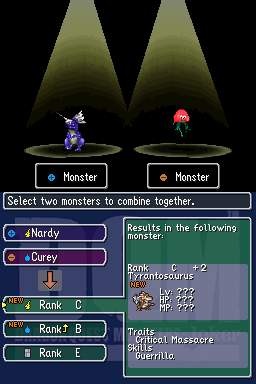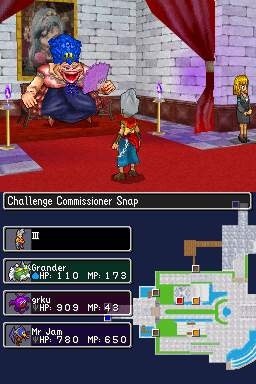The last time we saw a Dragon Quest Monsters game in North America was six years ago on the Game Boy Color, when the franchise still went by the moniker "Dragon Warrior." Importers aside, then, Dragon Quest Monsters: Joker for the Nintendo DS is a triumphant return to the Western world. Boasting gorgeous 3D visuals, a plethora of monsters to capture, and a compulsive monster-breeding system, this entry in the series should keep monster collection fans playing for hours on end. The emphasis on grinding, however, will make newcomers want to approach with caution.

Dragon Quest Monsters: Joker casts you in the role of a young monster-scout-to-be. You wake up in a prison cell, put there for trying to enter a monster-scouting tournament. Your father--who is the head of the supersecret CELL organization and threw you in there in the first place--sends for you and lets you join the tournament to fulfill an undercover mission for him. You are then given your choice of starting monster and head off to the tournament island via Jet Ski, where your adventure will begin in earnest. Along the way, you'll go on a scavenger hunt, encounter other scouts who challenge you, and befriend a mythical beast who has its own agenda. Kind of a weird set-up, but it fits the game's vibe.
Your quest is confined to seven islands, each of which requires Jet Ski travel to access. Exploration is limited to the mountains, caves, and palaces on these islands. There's no wandering around large continents or visiting various towns, so everything seems a little small in scope. However, there's still plenty of gameplay on each island, so while the lack of an epic feel may perturb those who were expecting a full-blown Dragon Quest role-playing experience, it doesn't take away from the depth of the core game.
With these sorts of games, after all, the emphasis is on collecting and synthesizing the massive roster of more than 200 monsters that populate the islands. Split across eight different known families and eight letter grades, many of these monsters--such as the lovable slimes--are recognizable if you've played through a Dragon Quest game. Within your first few encounters on each island, you can expect to come across several new monsters to battle, with many more as you venture deeper in. There's even a day-night cycle, so when you're outdoors, a whole different set of monsters comes out to play during nighttime.
There are no random battles here--each monster is visible on the world map, and you can ambush or avoid them as you please. You stay completely out of actual combat and are limited to using items, leaving the bloodletting to your monsters. You can have up to three monsters on hand at any time, with another three to switch in when outside of battle. The rest of your critters hibernate in a monster-storage vault. The turn-based battles are almost identical to those in other Dragon Quest games, with the option to fight, defend, or use any of your monsters' myriad special abilities. You can choose to take a hands-off approach by setting up such tactics for each monster as ordering them to mix up their abilities or avoid using magic. This system may seem a bit simple and antiquated, but "scouting" monsters--that is, recruiting them to your side--makes battles more appealing.
When you choose the scout command, each of your monsters takes a turn thwacking your target over the head without causing damage. Each hit increases the probability, measured in an onscreen percentage bar, that the target will join you. Even a weak party has a tiny chance of recruiting powerful monsters as long as it hits 1 percent. Since scouting power is linked to attack power, you can improve your chances by spending turns to boost up with support spells--at the risk that the monster will flee or defeat your party in the meantime. This makes you think about setting up "recruitment parties" and keeping secondary monsters up to snuff, since some magic users lack physical strength. This light strategy keeps things interesting and isn't overly complex.
When you scout monsters it brings them in at a high experience level, making them ideal for "synthesis," which is the merging of two beasts to create a new one. There are a few restrictions, one being that they must each be at least level 10. Each monster comes with a set of traits that determine what skills it can learn after leveling up, and when you synthesize, you'll have to choose three of the parents' traits for the new monster to inherit. You'll be thinking long and hard about which monsters and traits to keep or toss. Interestingly, you can create the same species with totally different abilities, and the possibilities are almost endless.
The caveat is that a newly synthesized beast starts off at a low level. Since you'll want to see what the next synthesis will yield, you'll feel compelled to level up your new baby. This will take a very long time if you want to keep everything synthesis-ready, but even without considering that, each new area is already tough to fight through if you don't grind. With only a smattering of nooks to explore and side quests to take, Dragon Quest Monsters doesn't do a very good job of masking the grinding process. Be prepared to run around in circles fighting the same enemies if you want to get a lot out of this game.
At least the game is a joy to look at as you grind. Akira Toriyama's trademark art style is represented very faithfully via cel-shaded character models roaming about an entirely 3D world. The coloring is vibrant, and most textures, while expectedly blocky due to the limitations of the DS hardware, are very detailed. The frame rate is smooth, and pop-in and broken seams are rare. The audio holds up its end of the bargain, with sound effects that are crisp rather than muddy and music that uses high-quality samples. The melodies could use a bit more variety, however, and while catchy and mostly cheery, they aren't entirely moving. Nevertheless, the presentation is still strong overall, both aesthetically and technically.
The game takes advantage of the DS's Wi-Fi technology too, though not to its fullest. You can battle and trade monsters over local wireless play, which is fine, but multiplayer battling over the Internet is noticeably absent. Square Enix has tried to make up for it by letting you battle against downloadable team data. By sending your team data online, the game will match it to five other teams on the network and download their data for you. You can win new monsters and items through these battles, or even just by signing into the network. It works well enough, and the items and monsters provide incentive, but the more competitive scouts out there will still miss pummeling their friends head-to-head.
Even with the lack of competitive online play, there's plenty to do in Dragon Quest Monsters: Joker. With such a variety of monsters to collect and ways to mold them to your liking, you'll spend hours upon hours past the main 25-hour story scouting and experimenting. Although the grinding can be a turn off, it's well worth the trouble if you desire the sense of satisfaction that comes with a massive, customized collection of beasts.
